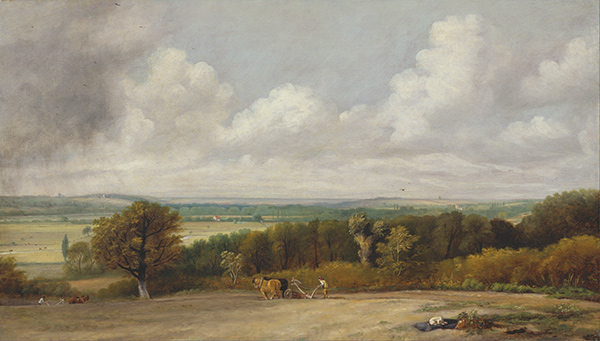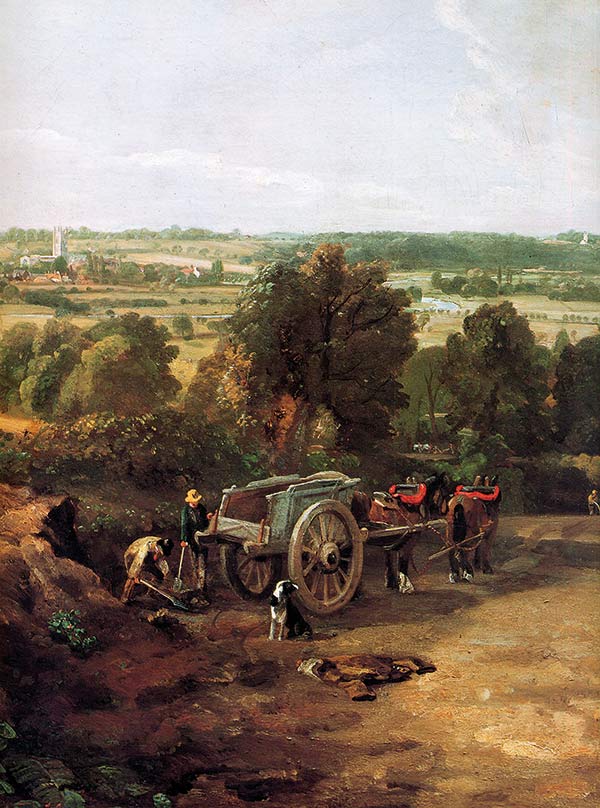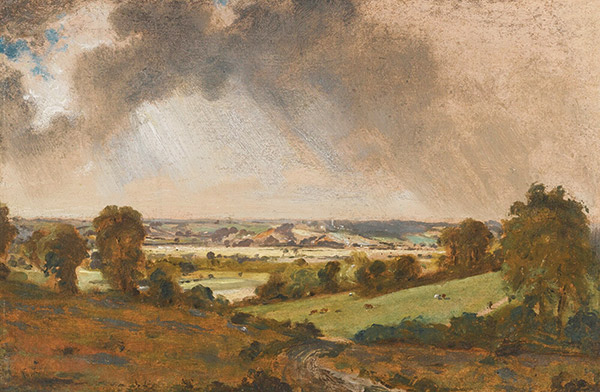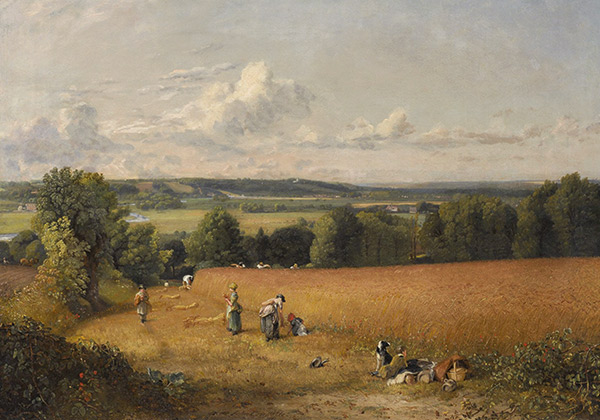Great item here as Cobbet went on to influence even Karl Marx. And it has a history that rings down to this very day and it is part and parcel of agricultural productivity. of course the small farmers made as much gross as the large field crops. after all they had their valuable dedicated labor to invest.
Today a wheat field produces a few hundred dollars per acre at best. so you need square miles to support millions of dollars of bfarm equipment. yet the same gross can be matched on 300 acres with three hundred cattle. and of course, high value crops can be grown on even an acre. We are doing this today.
best access to land needs to be the imperative of the natural community and land surplus to everyones needs can then be operated as an industrial operation. That industrial agriculture produces ample feed grains for supporting animal husbandry..
Saving the Commons
As the Industrial Revolution took off in Britain, William Cobbett rose in defense of the cottage economy.
By Jack Bell
JUNE 3, 2023
https://www.plough.com/en/topics/justice/environment/saving-the-commons?
In 1822, a journalist and radical named William Cobbett began a series of journeys by horseback through the countryside of southern England. His aim, he declared, was “not to see inns and turn-pike roads, but to see the country; to see the farmers at home, and to see the labourers in the fields.” To travel by turnpike – on the expanding network of toll roads designed to facilitate the commerce of goods destined for London – meant, he said, that you would “know nothing of England.” Instead, by crossing fields, commons, or the narrow lanes used by farmers and workers, you could see the people of England “without any disguise or affectation.”
Often traveling alone, Cobbett sought the most obscure pathways he could find, frequently going miles out of his way to avoid the smooth, newly constructed turnpikes he loathed. From his wanderings emerged Rural Rides, a wide-ranging sketch of rural life at the dawn of the Industrial Revolution. Rural Rides is a classic of nineteenth-century social criticism, pioneering new forms of travel and landscape writing; it was beloved by thinkers as different as Karl Marx and G. K. Chesterton. In the twenty-first century, it’s largely forgotten outside academic circles. But Cobbett’s critiques of enclosure make Rural Rides seem anything but dated.
From the early Middle Ages, the rural laboring classes in England had raised crops and livestock for their own personal use, even when they were not owners of the land they used. Access to this land was protected in different ways, and none more significant than the so-called rights of the common. Customs varied from village to village, but the rights of the common granted peasants (and later, the rural laboring classes) access to land for very specific purposes: to graze animals like cattle, sheep, and pigs; to harvest wild food and timber; to make hay; to glean after harvest; or to grow crops in very small allotments. The land might belong to a noble family, but those who lived on or near it had rights that the landowners and farmers were not supposed to interfere with. In many cases, the land peasants used was considered “waste,” or land that wasn’t tillable or worth improving.

John Constable, Ploughing Scene in Suffolk, oil on canvas, ca. 1825. All artwork public domain.
In the late eighteenth century, workers’ access to common resources came under attack. Numerous tracts of common and waste land were “enclosed” for tillage and grazing large flocks of sheep: rural families were forced off the land and their access to resources was severely curtailed. Modern agriculturalists like Arthur Young had promised landed English farmers increased capacity and higher yields through enclosure and monocropping. Following this cue, many landowners and farmers sought ways to absorb common and waste lands into their own agricultural holdings. Parliament assisted these efforts: from 1750 to 1850, it passed five thousand acts that restricted rural workers’ access to what had been common resources. London banks provided the loans necessary to clear the land of laborers and wildlife and grow crops; the new laws let owners do so. In some instances, the land was simply annexed without parliamentary consent. One estimate suggests that by the middle of the twentieth century, nearly one-fifth of England’s land mass had transitioned from common to private use.
For farmers and landowners, enclosure was often a financial windfall. For those who lived and worked on the land, enclosure was a catastrophe. Although there were multiple forces conspiring against rural workers, enclosure amounted to what the economic anthropologist Karl Polanyi called “a revolution of the rich against the poor.” Cobbett himself described it as a “shutting out of the labourers from all share in the land,” forbidding them to even “look at a wild animal, almost at a lark or a frog.” Enclosure was an ecological disaster too. Landowners who took possession of commons would tear down hedgerows, fill in ditches, drain ponds, and raze forests. With the natural biodiversity of the commons destroyed, farmers grew cash crops like wheat or barley on what remained. And enclosure imposed dire legal consequences on the hunting and foraging rural people had tacitly agreed upon for generations, destroying long-established customary arrangements of give-and-take that had supported the rural community.
Rural Rides documents the social consequences of enclosure and the centralization of agriculture. It tells us of workers’ habits of dress, the state of their farms, the condition of the cottages they lived in. It also describes how enormous damage to the natural world impoverished the people who depended upon it. Long before more recent calls to return to indigenous methods of agriculture and land stewardship, Cobbett perceived the significance of farming with nature rather than against it: hedge-laying, tree-planting, coppicing, and other aspects of mixed, small-scale agriculture. This longstanding cottage economy not only encouraged enclaves of wildness in a landscape dominated by increasingly centralized agricultural systems, it had long helped the rural poor avoid dependence on parish relief or the chance of having a benevolent landlord. Cobbett called for his country’s ruling classes to give back the common land they had stolen from their own people.

John Constable, Stour Valley and Dedham Church, oil on canvas, ca. 1815 (detail)
Cobbett was politically radical and theologically prescient. Rural Rides expresses the view of a world where the land is a common inheritance for all, not the property of a few. In an era where the systems of centralization and control Cobbett critiqued have led to an ecological crisis of existential proportions, we would do well to reconsider Rural Rides’s vehement critique of a system incapable of recognizing moral or environmental limits.
William Cobbett was born in 1763 in the village of Farnham in Surrey, a place where, he would later write, “all is a garden.” His father was a farmer. Cobbett would recall that his earliest memory of work was “driving the small birds from the turnip-seed, and the rooks from the peas.” Intriguingly, Cobbett spent the first half of his life actively seeking to become a landowning farmer. As a young man, he worked for his father and on neighboring farms until in 1783 he mysteriously left home for London. Having learned to read and write on the farm, he found work as an attorney’s clerk before another change of heart, joining the Royal Marines in 1784. In 1791 he was honorably discharged and, after marrying in 1792, set sail for America. Once across the Atlantic, he established a new career as an anti-American pamphleteer, writing under the pseudonym “Peter Porcupine.”
How did an orthodox Tory become a relentless critic of Crown and Parliament and a champion of the rural poor? As Raymond Williams points out, when Cobbett finally returned to England after fifteen years abroad, he had earned “a reputation … as one of the most vigorous, indeed virulent, anti-democratic journalists” of the day. Yet “within five years he is a radical; within ten in jail for sedition.” Cobbett’s road to radicalism began with the fulfillment of a lifelong dream. In 1805, he finally became a landowner.
After their return from America, Cobbett relocated his family to Botley, in Hampshire, where he purchased a farm. But soon afterward, a small parcel of land nearby (some common land, some waste) prompted a local political crisis. Farmers in the area wished to enclose the land, but they ran into stiff opposition – not least from Cobbett himself.

John Constable, Dedham Vale, with a View to Langham Church from the Fields Just East of Vale Farm, East Bergholt, oil on canvas, ca. 1815
The nearly thirty smallholdings at Horton Heath raised sheep, cattle, poultry, hogs, and bees; cut firewood; and tended gardens in the midst of apple orchards and cherry trees. By Cobbett’s estimate, these people “produced as much for themselves and for the market [on 150 acres of common and waste land] as any neighboring two-hundred-acre farm.” What impressed Cobbett most was that they did this on land that was entirely “unimproved” by contemporary agricultural-reform standards. Cobbett proposed to other local landowners that each family should retain a small parcel of land. His fellow farmers rejected this, because they saw the smallholders’ independence as a school for insolence and an inevitable financial drain on the parish. Cobbett’s proposal was defeated. Soon after, Horton Heath was enclosed and its tenants expelled. It was a defining moment in Cobbett’s life. From then until his death in 1835, he made the cause of the rural and urban poor his own.
The politics of enclosure would provoke Cobbett’s journalistic ire for the rest of his life. Beneath the politics, Cobbett perceived a root cause: the failure of elites to acknowledge the thrift, productivity, and resilience of the cottage economy. Indeed, Rural Rides was a success because Cobbett was able to marry political critique with a fresh vision of the agricultural landscape and its people. He often begins by noticing and describing ordinary things: the quality of the turnips in a field, the vigor of hop plants twisting up their poles, the condition of a flock of snow-white ewes grazing in wheat stubble. It’s a practical attention rooted in a love for the subtle variations of place – even ordinary and familiar ones.
Soils are Cobbett’s favorite places to begin. At Hascombe Beech in Surrey, for instance, the ground is “a beautiful loam upon a bed of sand. Springs start here and there at the feet of the hills, and little rivulets pour away in all directions.” On the way from Winchester to Burghclere, in Hampshire, the soil is transformed into a “coverlet of flints upon a bed of chalk” before giving way to a “high, chalk bottom, open downs or large fields, with here and there a farm-house in a dell, sheltered by lofty trees, which, to my taste, is the most pleasant situation in the world.” The hills from Hindhead to Blackdown (outside Guildford, Surrey) look like boiling copper in a pot “if you could, by word of command, make it be still.” He is captivated by the “hangers” of the East Hampshire Hills, not far from where he was born (“never, in all my life, was I surprised and so delighted”). There, “the trees and underwood hang, in some sort, to the ground,” Cobbett noted, “instead of standing on it.” Many of these hangers remain, and you can still find the paths by them that Cobbett himself likely used.
Cobbett’s eye for detail wasn’t confined to the agricultural features of a landscape. He delights in what the poet Jeremy Hooker calls “ditch vision,” the ability to spot wild things in ordinary and domesticated places. Crisscrossing the pastures and crops around Everley, in Wiltshire, Cobbett can’t help but bring himself back to a “clump of lofty sycamores” in which resides “a most populous rookery, in which, of all things in the world, I delight.” These interludes of wildness are thrilling to him. Many times, Cobbett’s observational pleasures place the reader right alongside him as he puts pen to paper: “I am now sitting at one of the southern windows of this inn, looking across the garden towards the rookery. It is nearly sun-setting; the rooks are skimming and curving over the tops of the trees; while, under the branches, I see a flock of several hundred sheep coming nibbling their way in from the Down, and going to their fold.” On one journey, Cobbett is surprised by thousands of goldfinches picking their way through the thistle that lines the path in front of him. The thistle in the field has been hauled away with the hay crop, so the birds flock to seedheads growing unmown along the road. They stay beside him for half a mile until they move off as one.

John Constable, The Wheat Field, oil on canvas, 1816
For Cobbett, these little enclaves of wildness weren’t just aesthetically remarkable; they had political significance. A few days into his first rural ride, he notices that the most prosperous laborers live in places where tillage agriculture hasn’t destroyed old forests and hedgerows. The wildness of the land and the welfare of the rural poor were inseparably linked. Destroy the wild places, and you destroy the livelihood of the people living there. Let wild places thrive, and those people will thrive too. It’s a kind of law in Rural Rides that “the more purely a corn country, the more miserable the labourers.” (“Corn country” has been turned over solely to the production of grain.) In Thanet, a fertile peninsula that he describes as “ten square miles of corn,” Cobbett makes his case. In such places “the great big bull frog grasps all. In this beautiful island every inch of land is appropriated by the rich. No hedges, no ditches, no commons, no grassy lanes: a country divided into great farms; a few trees surround the great farmhouse. All the rest is bare of trees; and the wretched labourer has not a stick of wood, and has no place for a pig or cow to graze, or even to lie down upon.” Cobbett’s point is both ecological and social. Enclosure and agricultural “improvement,” he saw, suppressed the vitality of the land. It also suppressed the people who tended and kept it. Cobbett observes that in places where ponds have been turned into cropland, wild waterfowl are nowhere to be found. And he laments the clear decline in the habitat of wild rabbits: woods, hedges, the edges of fields. These ecological losses carry social consequences: rural people no longer have access to traditional food sources over winter.
According to Cobbett, the promises of agricultural “progress” could be debunked by simply looking at the cottage economies of people who inhabited “unimproved” land. For example, he notes that the wildest, least-improved places yielded the best livestock and provided inhabitants a dependable source of income. “How curious is the natural economy of a country!” Cobbett remarks upon passing through the supposedly “wretched tracts” of Romney Marsh in Kent. The wastes, heaths, and commons of this place – “unspoilt (so far) from the touches of the Wen” – are unimproved. (A wen is an unsightly facial cyst, and it was Cobbett’s preferred description of the conurbations that swelled around London.) And yet, Cobbett notes, “wastes” like the Fen country produce the fattest cattle he can find anywhere in England. The problem is that enclosure threatened to wipe away such realities from the face of the earth. Destroy the natural landscape, and the memory of the way of life that landscape sustained disappears forever.
This insight led Cobbett to an impassioned defense of traditional rural crafts. He wrote one of the first studies in agroforestry, The Woodlands. Another book, The Cottage Economy, sought to revive crafts like brewing, baking, gardening, and pig butchery. These concerns have an oddly contemporary air: agroforestry, the incorporation of tree crops with more traditional forms of agriculture, is a booming field. Gardening and homesteading are suddenly popular again.
Cobbett was more than a pioneer in ecological activism. Driving his politics is an account of creation that denies any human pretension to absolute ownership:
The land, the trees, the fruits, the herbage, the roots are, by the law of nature, the common possession of all the people. … And, if a contingency arise, in which men … are unable, by moderate labour … to obtain food sufficient for themselves and their women and children, there is no longer benefit and protection to the whole; the social compact is at an end, and men have a right, thenceforward, to act agreeably to the laws of nature.
For Cobbett, these “laws of nature” have revolutionary implications. The divinely instituted bond between “all the people” and the creation they hold in common – “the land, the trees, the fruits, the herbage, and the roots” – has been severed, he implies, by the emergent capitalist order. In early industrial England, workers own neither land nor industry; neither the farmworker nor the factory hand is able to enjoy the fruits of his labor. Cobbett maintains that a robbery has taken place:
Is a nation richer for the carrying away of the food from those who raise it, and giving it to bayonet men and others, who are assembled in great masses? I could broomstick the fellow who would look me in the face and call this “an improvement.” … [England] is the free-est country in the world; but, somehow or other, the produce is, at last, carried away; and it is eaten, for the main part, by those who do not work.
The criminals of England are not the starving poor who steal food they cannot afford, but the rich, who devise clever financial systems that siphon away food produced by laborers and sell it for a profit in the cities or abroad. Cobbett put these ideas to the test upon meeting a group of angry farmers on the road, intent on punishing an elderly man for stealing cabbages. “Would you punish a man, a poor man … and, moreover, an old man,” Cobbett asks them, “when that Holy Bible, which I dare say you profess to believe in … teaches you that the hungry man may, without committing any offense at all, go into his neighbor’s vineyard and eat his fill of grapes?” When the men insist that this fellow is a “bad man,” Cobbett reminds them that “the Bible, in both Testaments, commands us to be merciful to the poor, to feed the hungry, to have compassion on the aged; and it makes no exception as to the ‘character’ of the parties.”
Decades after Cobbett published Rural Rides, Karl Marx identified a rift in “the social-ecological metabolism” of the earth. Industrial capitalism, he argued, not only alienated the worker from his labor but also “hinder[ed] the operation of the eternal natural condition for the lasting fertility of the soil.” In an industrial economy, agricultural products were consumed in the city. Once those products were consumed, how was a capitalist society supposed to return fertility to the soil? Trade, commerce, and the circulation of agricultural goods across long distances generated a “metabolic rift” between the country and the city. Marx predicted a looming agricultural catastrophe: eventually, capitalism would exhaust the fertility of the soil.
There is more than a little Cobbett in Marx’s theory of a “metabolic rift.” Marx was a great admirer of Cobbett; he described him as “the purest incarnation of Old England and the most audacious initiator of Young England. … As a writer he has not been surpassed.” For Marx, Cobbett was one of the few genuine revolutionaries of his generation. But Cobbett was revolutionary in the wrong direction, Marx thought: Cobbett wanted to turn the wheel of economic history backward, not forward. There’s some truth to Marx’s critique of Cobbett as a nostalgist: some of the old radical’s opinions are reactionary or even racist, like his hatred of potatoes (they’re from Ireland). But as the crisis Cobbett chronicled continues and acquires global proportions, with industrial agribusiness waging an unceasing war against nature, we stand in desperate need of new ways of relating to the earth. Those new ways will no doubt include the dignity, thrift, and productivity of the cottage economy that Cobbett celebrated in Rural Rides and which he himself practiced. In the end, Cobbett gestures toward the possibility that we might inhabit the earth without abusing it or each other; he contemplates how to take what we need for survival and possibly, if improbably, contribute to the flourishing of all the creatures with whom we share the natural world. In the kind of paradox Cobbett delighted in, the key to our future might very well lie in the wisdom of the past.

No comments:
Post a Comment